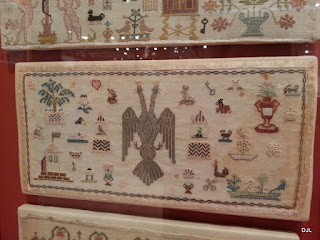I owe huge thanks to Barbara Hutson for telling me to look for the sampler wall at the International Folk Art Museum in Santa Fe. It's funny, but when I asked at the desk where I'd find this, the nice young lady did not really know what I was talking about. At first, I was afraid that these samplers were no longer on exhibit, but were hidden back in storage. And then I turned a corner and found them! An large free standing wall filled with samplers.
There's an amazing lack of information about these samplers. So I can't really tell you much. But I can show you some of them.
I love this one with the two-headed eagle. Anyone have any ideas on country of origin?
Is this a man with a hot-air balloon?
The one with the weeping willow is the only sampler with American origins.
Yikes. This one has some serious goldwork. But I just have to wonder what got cut out?
Now remember. If you're ever in Santa Fe, you need to stop here. I wish I had got decent photos of all of them, but alas glass and lights sometimes interfere with cameras. In fact, the entire Girard collection is amazing. Everytime you turn a corner, you have no idea what you may see!






















12 comments:
The double headed eagle is used mostly by eastern European countries. Many countries use it, unfortunately.
The double-headed eagle is Russian I think.
http://en.wikipedia.org/wiki/Double-headed_eagle
The real question about the double-headed eagle isn't so much about which cultures/countries used this as a symbol, it's more about which ones would have included it in needlework. I have found one small image of a sampler that was in a Skinner auction that included a small double-headed eagle that they would only guess as being Anglo-American. This particular eagle was also adopted as a symbol by the Scottish Rites of Freemasonry and there's a beautiful example of one on top of a column on a Masonic building in Washington D.C. Guess I need to go search my sampler books.
I think of it as Hungarian for some reason.
I think of it as Hungarian (the Magyar double eagle) for some reason.
I have really enjoyed this post and have copied the pictures onto my ipad as I plan to study the samplers in detail. Thank you for taking the time to share these with us.
Wonderful! Thanks for sharing -- I've loved looking through your past few travel posts.
Hi Donna, I have found your blog thru a post from Barbara, what a huge treat to have seen this exhibit! Wow! They are all so beautiful. I would guess that the double headed eagle may be of German origin, and also the one with the angel. Many are reminiscent of the designs I have seen at the European Reproduction Samplers website. Thank you so much for sharing these pics!
WOw! I wish I had gone to this museum instead of Georgia O'Keefe. THough hers was interesting, this is more me.
I'm going to recommend my sampler guild go to your site.
Thanks for sharing!
JHM
http://needleworkerssamplings.blogspot.com/
Wow it's fantastic. Thx for sharing.
I have several Spanish samplers from the 19th century that feature the double-headed eagle. I think it was the symbol of the Hapsburg Empire, among others.
WOW! That was worth the whole trip!! Gorgeous :) Thank you so much for sharing!
Post a Comment